We Scar Many TreesBy Mick Harding
We, the Taungurung people of this Biik (Country), have been removing the bark from trees to use for various purposes - such as baby carriers, food collection vessels, bark canoes and thatching for our dwellings - for at least 2000 generations.
These carvings symbolise our relationship to the Warring (Goulburn River) and its associated rivers, creeks and Ngarrak (Mountains).
These symbols we carve, have been used to articulate our relationship to our Ancestors and Country, as Kulin people for thousands of years.
Along the length of the Great Victorian Rail Trail (GVRT), we have removed the bark from healthy eucalypts, and then carved a message in the sapwood.
Each tree we have scarred has marks at the top that represent how our old people cut and scarred their bodies. This is how they demonstrated their relationships to one another.
Underneath these marks, are the designs that tell different aspects of our connection to our Biik and each other.
The bark we have removed will be used for different purposes. I will dry and mark the inside of the bark with different motifs to tell stories about our relationship to our Ancestors and Country.
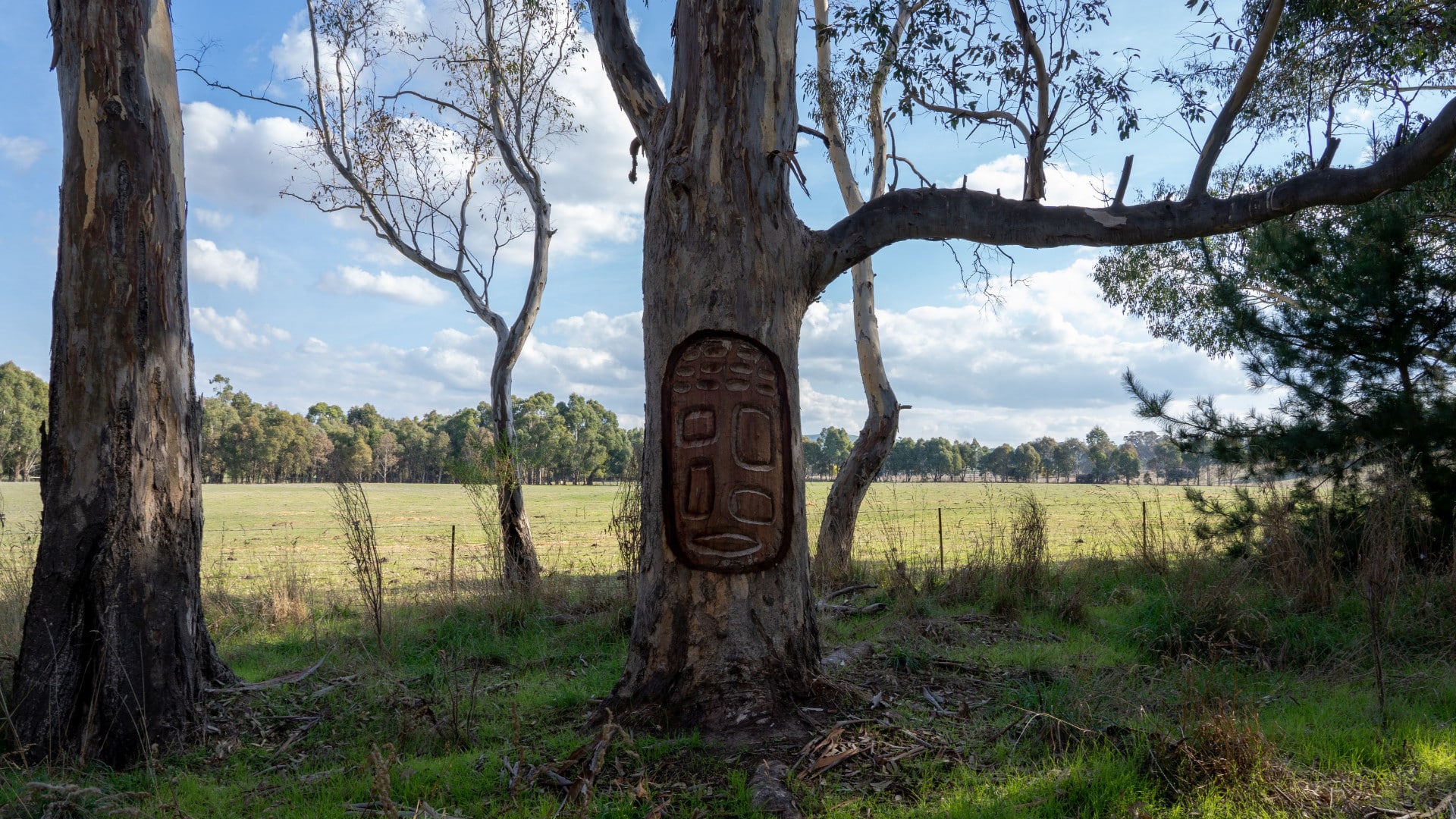
Liwik
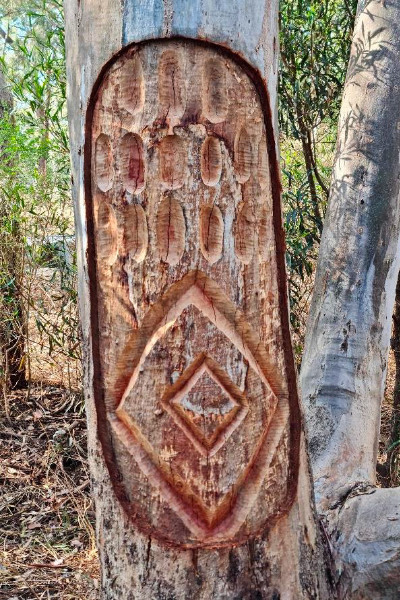
Liwik nugal-nganjin
Burran-dabu gurrin
Gerrabinon yuma-k
Yuma-k gurrin
Gilbruk ngam liwik
nugal-nganjin.
Our Old Peoples’ scars were marks of belonging and relationship. These are marks to respect and acknowledge them.
Liwik nugal-nganjin mooran. Our Ancestors are alive.
Marram-nganjin warr-ngat
Maniga-dhan Liwik nugal-nganjin.
Marram-nganjin gilbruk maniga-dhan.
We walk in our Ancestors footsteps.
We respect them.
Mountains
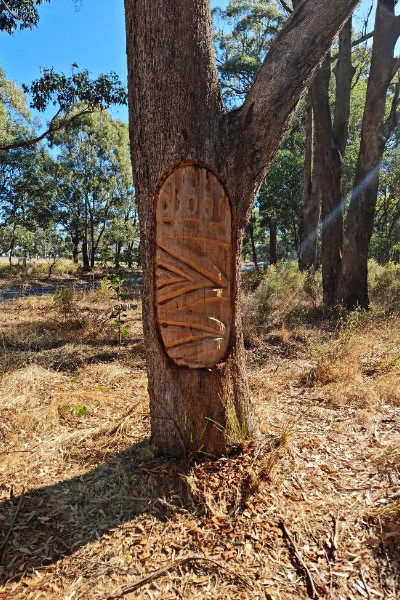
Liwik nugal-nganjin
Burran-dabu gurrin
Gerrabinon yuma-k
Yuma-k gurrin
Gilbruk ngam liwik
nugal-nganjin.
Our Old Peoples’ scars were marks of belonging and relationship. These are marks to respect and acknowledge them.
Water is everything.
Baan gurrin miimigat
Ngarrak wurrdha gurrin
Winda gurnang wurrdha nugal-nganjin mingu
The mountains and Strathbogie Ranges are where our watercourses start.
Inanimate Objects
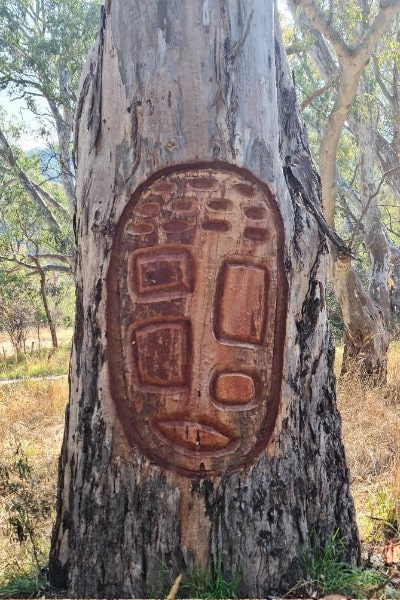
Liwik nugal-nganjin
Burran-dabu gurrin
Gerrabinon yuma-k
Yuma-k gurrin
Gilbruk ngam liwik
nugal-nganjin.
Our Old Peoples’ scars were marks of belonging and relationship. These are marks to respect and acknowledge them.
Murrup wonggo
Guding-bunin
Biik nugal-nganjin
There is spirit in our land everywhere.
Liwik
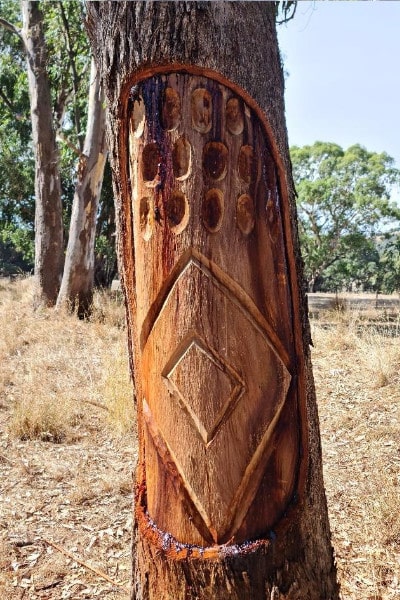
Liwik nugal-nganjin
Burran-dabu gurrin
Gerrabinon yuma-k
Yuma-k gurrin
Gilbruk ngam liwik
nugal-nganjin.
Our Old Peoples’ scars were marks of belonging and relationship. These are marks to respect and acknowledge them.
Liwik nugal-nganjin mooran.
Our Ancestors are alive.
Marram-nganjin warr-ngat
Maniga-dhan Liwik nugal-nganjin.
Marram-nganjin gilbruk maniga-dhan.
We walk in our Ancestors footsteps.
We respect them.
Tarnuk
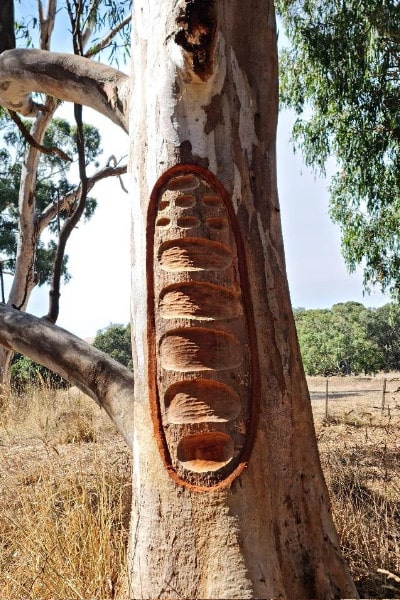
Liwik nugal-nganjin
Burran-dabu gurrin
Gerrabinon yuma-k
Yuma-k gurrin
Gilbruk ngam liwik
nugal-nganjin.
Our Old Peoples’ scars were marks of belonging and relationship. These are marks to respect and acknowledge them.
Dabu miimigat gurringunga-nan
Bark is used for everything
Dabu-nan
Dabu-yilam
Dabu-daanak
Dabu-gorgong-wurrdhabu
nugal-nganjin gunga-nan munga-k
We use bark to make containers, house thatching and canoes to travel on watercourses.
Living things in the water
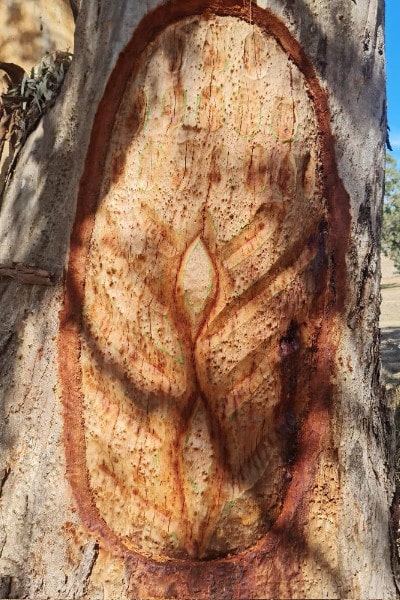
Liwik nugal-nganjin
Burran-dabu gurrin
Gerrabinon yuma-k
Yuma-k gurrin
Gilbruk ngam liwik
nugal-nganjin.
Our Old Peoples’ scars were marks of belonging and relationship. These are marks to respect and acknowledge them.
Gurnang wurrdha
Gurrin yilam
Miimigat wonggo
Water courses are home to many creatures.
Gurnang wurrdha gurrin
Miimigat wonggo
Gurrin mooran.
All life depends on water, it is why life exists.
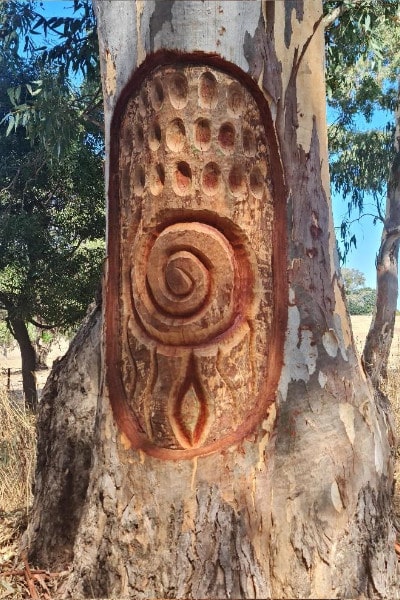
Liwik nugal-nganjin
Burran-dabu gurrin
Gerrabinon yuma-k
Yuma-k gurrin
Gilbruk ngam liwik
nugal-nganjin.
Our Old Peoples’ scars were marks of belonging and relationship. These are marks to respect and acknowledge them.
Monmut mobran gurrin
Wind is alive.
Monmut gumak
Biik nugal nganjin
Derrandel wurrdha
Windala dinumari-a monmut
The winds on our Country carry seeds all over our Country.
Liwik
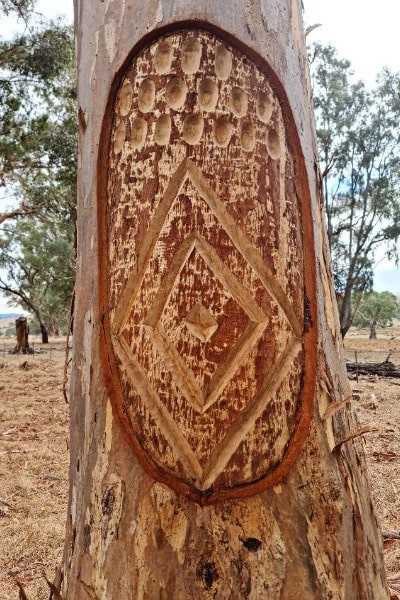
Liwik nugal-nganjin
Burran-dabu gurrin
Gerrabinon yuma-k
Yuma-k gurrin
Gilbruk ngam liwik
nugal-nganjin.
Our Old Peoples’ scars were marks of belonging and relationship. These are marks to respect and acknowledge them.
Liwik nugal-nganjin mooran.
Our Ancestors are alive.
Marram-nganjin warr-ngat
Maniga-dhan Liwik nugal-nganjin.
Marram-nganjin gilbruk maniga-dhan.
We walk in our Ancestors footsteps.
We respect them.
Goulburn River and mountain ranges either side
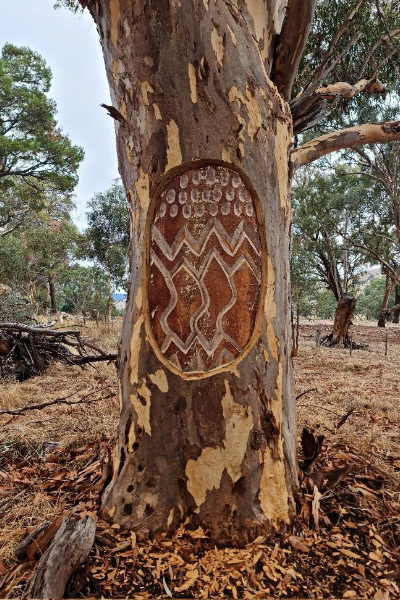
Liwik nugal-nganjin
Burran-dabu gurrin
Gerrabinon yuma-k
Yuma-k gurrin
Gilbruk ngam liwik
nugal-nganjin.
Our Old Peoples’ scars were marks of belonging and relationship. These are marks to respect and acknowledge them.
Waring wurrdhabu
Barring wurrdhabu
The Goulburn River is our central watercourse or track.
Waring barring
Yananindon
Ngarrak wurrdha
The Goulburn River cuts its way through the Strathbogie Ranges all the way to the Murray River.
Tarnuk
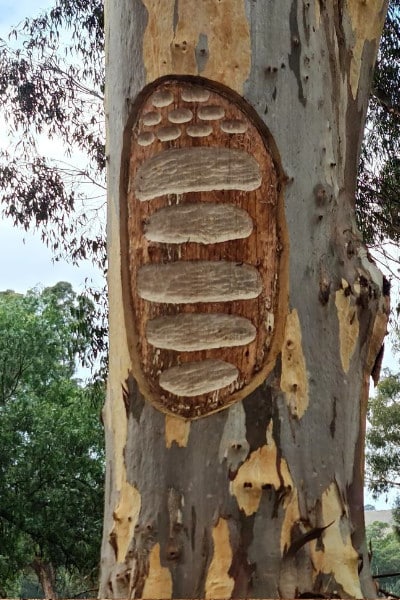
Liwik nugal-nganjin
Burran-dabu gurrin
Gerrabinon yuma-k
Yuma-k gurrin
Gilbruk ngam liwik
nugal-nganjin.
Our Old Peoples’ scars were marks of belonging and relationship. These are marks to respect and acknowledge them.
Dabu miimigat gurringunga-nan
Bark is used for everything
Dabu-nan
Dabu-yilam
Dabu-daanak
Dabu-gorgong-wurrdhabu
nugal-nganjin gunga-nan munga-
We use bark to make containers, house thatching and canoes to travel on watercourses.
Inanimate objects
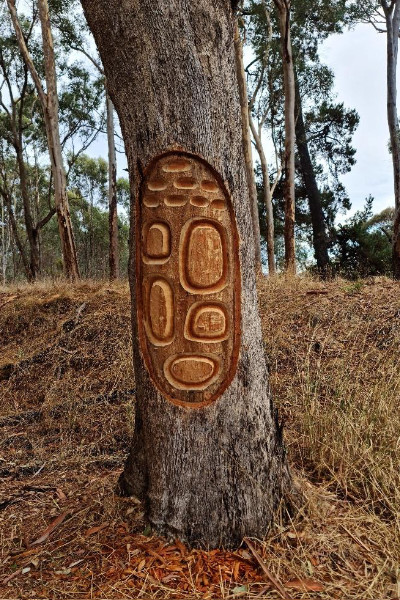
Liwik nugal-nganjin
Burran-dabu gurrin
Gerrabinon yuma-k
Yuma-k gurrin
Gilbruk ngam liwik
nugal-nganjin.
Our Old Peoples’ scars were marks of belonging and relationship. These are marks to respect and acknowledge them.
Murrup wonggo
Guding-bunin
Biik nugal-nganjin
There is spirit in our land everywhere.
Goulburn River
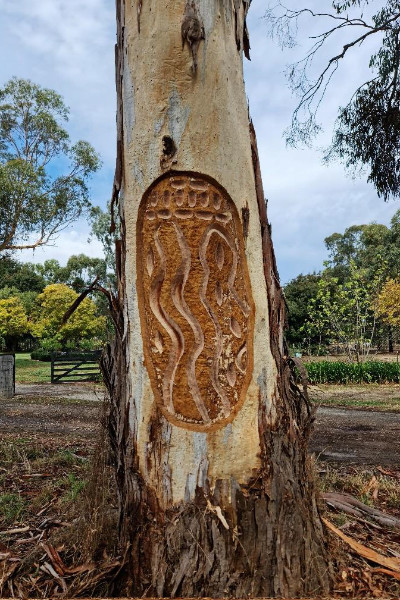
Liwik nugal-nganjin
Burran-dabu gurrin
Gerrabinon yuma-k
Yuma-k gurrin
Gilbruk ngam liwik
nugal-nganjin.
Our Old Peoples’ scars were marks of belonging and relationship. These are marks to respect and acknowledge them.
Waring mooran gurrin.
The Goulburn River is alive.
Waring goork-mgada mooran gurrin
Miimigat wonggo.
The Goulburn River is the lifeblood for everything in and around it.
Inanimate Objects
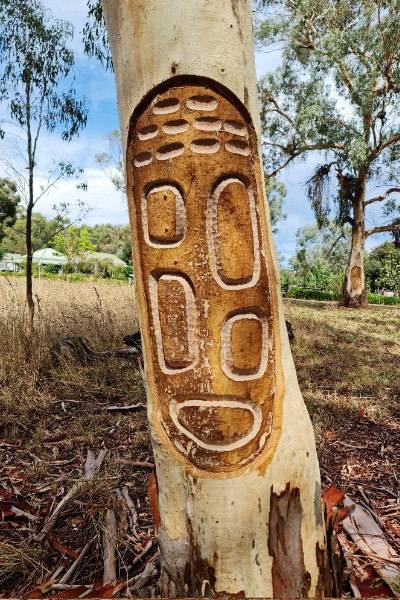
Liwik nugal-nganjin
Burran-dabu gurrin
Gerrabinon yuma-k
Yuma-k gurrin
Gilbruk ngam liwik
nugal-nganjin.
Our Old Peoples’ scars were marks of belonging and relationship. These are marks to respect and acknowledge them.
Murrup wonggo
Guding-bunin
Biik nugal-nganjin
There is spirit in our land everywhere.
Liwik
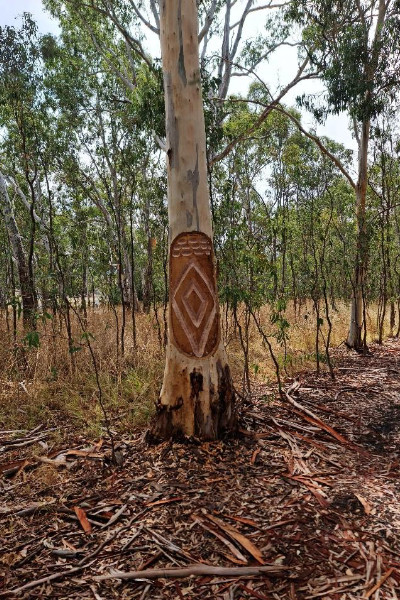
Liwik nugal-nganjin
Burran-dabu gurrin
Gerrabinon yuma-k
Yuma-k gurrin
Gilbruk ngam liwik
nugal-nganjin.
Our Old Peoples’ scars were marks of belonging and relationship. These are marks to respect and acknowledge them.
Liwik nugal-nganjin mooran.
Our Ancestors are alive.
Marram-nganjin warr-ngat
Maniga-dhan Liwik nugal-nganjin.
Marram-nganjin gilbruk maniga-dhan.
We walk in our Ancestors footsteps.
We respect them.
Inanimate objects
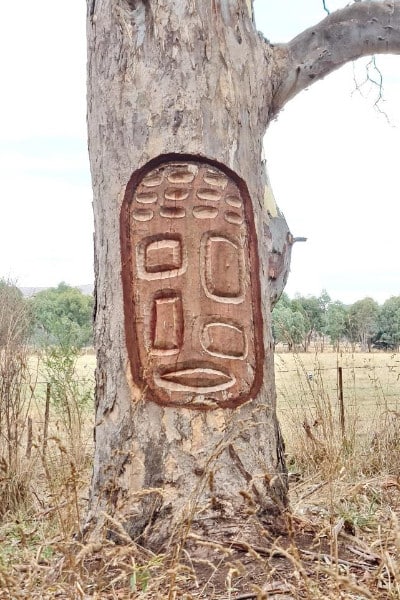
Liwik nugal-nganjin
Burran-dabu gurrin
Gerrabinon yuma-k
Yuma-k gurrin
Gilbruk ngam liwik
nugal-nganjin.
Our Old Peoples’ scars were marks of belonging and relationship. These are marks to respect and acknowledge them.
Murrup wonggo
Guding-bunin
Biik nugal-nganjin
There is spirit in our land everywhere.
Liwik
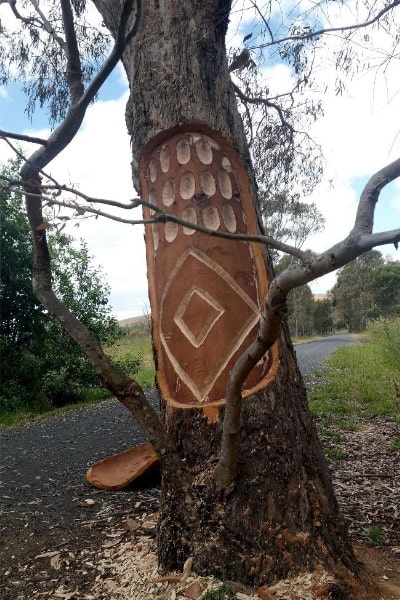
Liwik nugal-nganjin
Burran-dabu gurrin
Gerrabinon yuma-k
Yuma-k gurrin
Gilbruk ngam liwik
nugal-nganjin.
Our Old Peoples’ scars were marks of belonging and relationship. These are marks to respect and acknowledge them.
Liwik nugal-nganjin mooran.
Our Ancestors are alive.
Marram-nganjin warr-ngat
Maniga-dhan Liwik nugal-nganjin.
Marram-nganjin gilbruk maniga-dhan.
We walk in our Ancestors footsteps.
We respect them.
Tarnuk
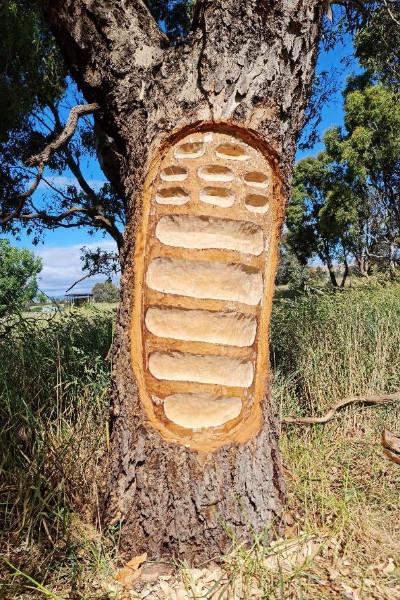
Liwik nugal-nganjin
Burran-dabu gurrin
Gerrabinon yuma-k
Yuma-k gurrin
Gilbruk ngam liwik
nugal-nganjin.
Our Old Peoples’ scars were marks of belonging and relationship. These are marks to respect and acknowledge them.
Dabu miimigat gurringunga-nan
Bark is used for everything
Dabu-nan
Dabu-yilam
Dabu-daanak
Dabu-gorgong-wurrdhabu
nugal-nganjin gunga-nan munga-k
We use bark to make containers, house thatching and canoes to travel on watercourses.
Rivers, creeks and travelling routes
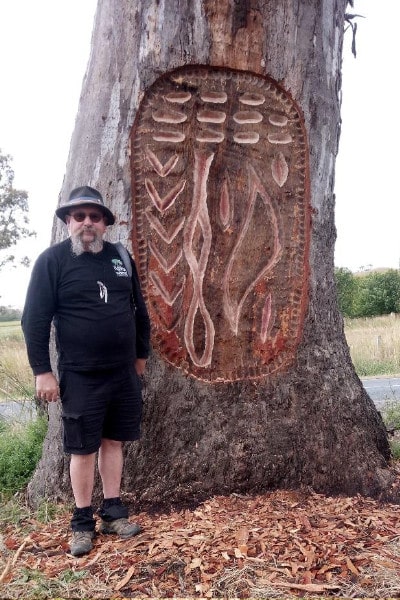
Liwik nugal-nganjin
Burran-dabu gurrin
Gerrabinon yuma-k
Yuma-k gurrin
Gilbruk ngam liwik
nugal-nganjin.
Our Old Peoples’ scars were marks of belonging and relationship. These are marks to respect and acknowledge them.
Baan mooran gurrin
Water is a living thing.
Gurnang darridibup yananinon
Barring nugal-nganjin.
The rivers and creeks are our highways and travelling routes.
Tarnuk
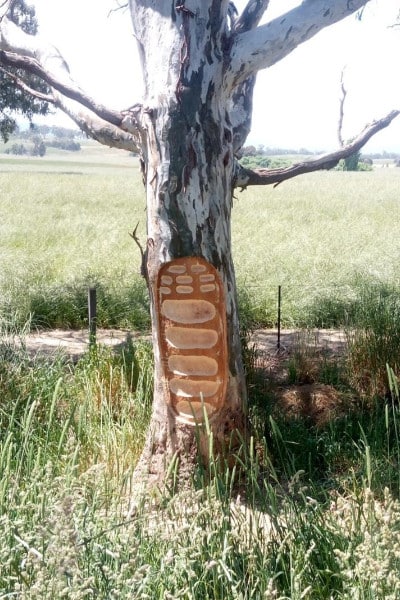
Liwik nugal-nganjin
Burran-dabu gurrin
Gerrabinon yuma-k
Yuma-k gurrin
Gilbruk ngam liwik
nugal-nganjin.
Our Old Peoples’ scars were marks of belonging and relationship. These are marks to respect and acknowledge them.
Dabu miimigat gurringunga-nan
Bark is used for everything
Dabu-nan
Dabu-yilam
Dabu-daanak
Dabu-gorgong-wurrdhabu
nugal-nganjin gunga-nan munga-k
We use bark to make containers, house thatching and canoes to travel on watercourses.
Liwik
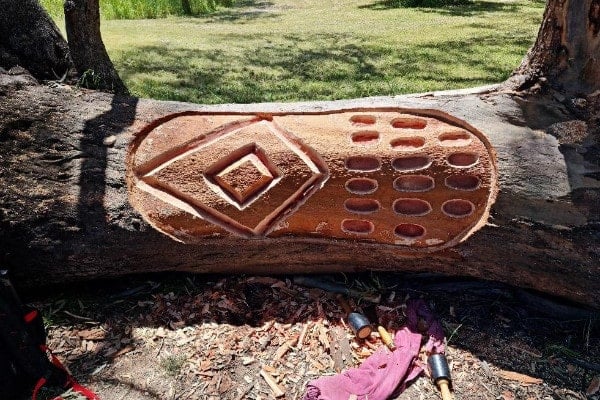
Liwik nugal-nganjin
Burran-dabu gurrin
Gerrabinon yuma-k
Yuma-k gurrin
Gilbruk ngam liwik
nugal-nganjin.
Our Old Peoples’ scars were marks of belonging and relationship. These are marks to respect and acknowledge them.
Liwik nugal-nganjin mooran.
Our Ancestors are alive.
Marram-nganjin warr-ngat
Maniga-dhan Liwik nugal-nganjin.
Marram-nganjin gilbruk maniga-dhan.
We walk in our Ancestors footsteps.
We respect them.
About the artist
Mick Harding
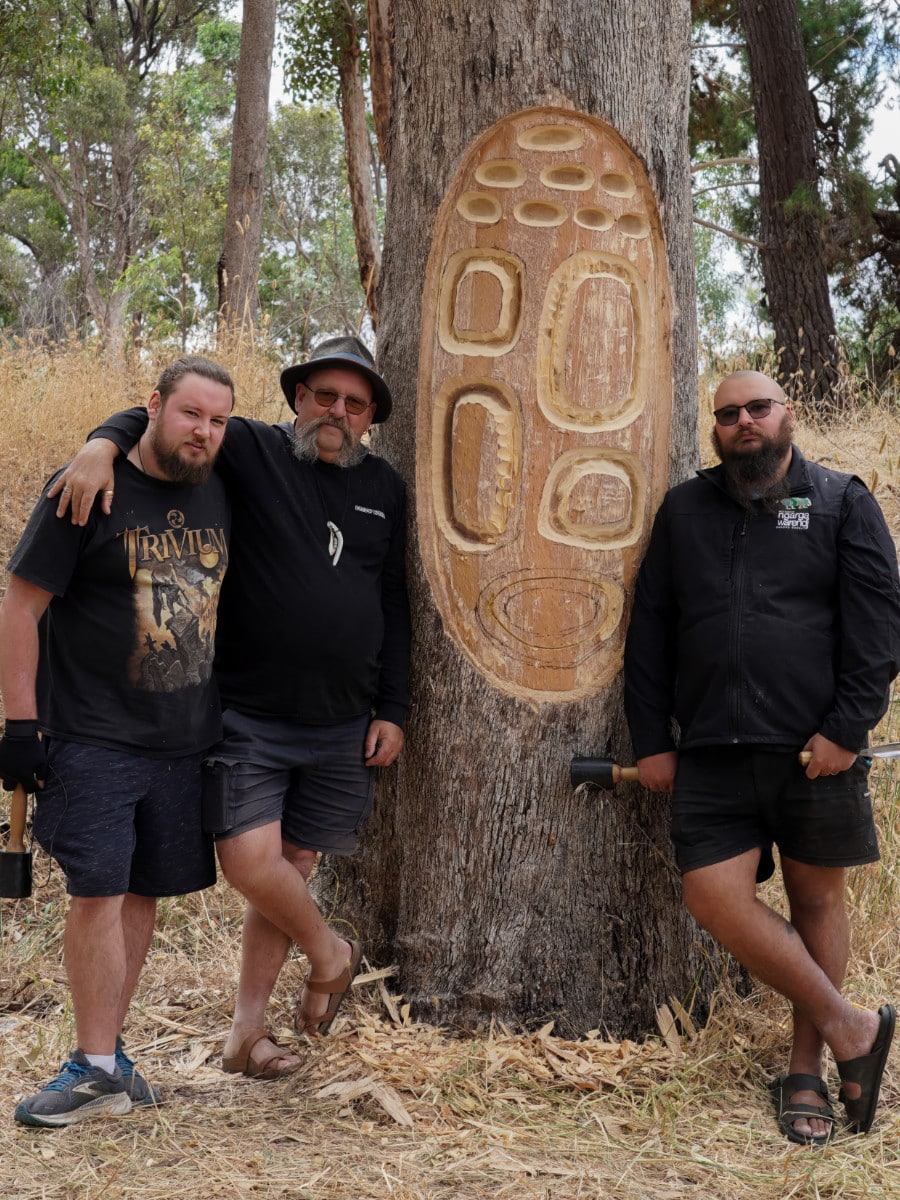
Belonging to the Yowong-Illam-Baluk and Nattarak Baluk clans of the Taungurung people, Mick Harding is an artist specialising in wood working, sculpture, printmaking and giftwares.
For Mick, `art is a rainbow of many things' and his own practice demonstrates this openness to innovative design. His company, Ngarga Warendj-Dancing Wombat, is known for high-quality products that are produced by hand or through ethical licensing agreements. His sculpture commissions have been highly sought by a wide range of clients.
Mick is also a cultural educator and his commitment to knowledge is reflected in the cultural narratives that inform his works. Mick notes the importance of his art making as a way to be both culturally and financially independent. His art is also for his children and community and he says that buying genuine products from Indigenous artists `puts money into our pockets and into our communities - we are closing the gap ourselves.'
Mick showed an interest in art at a young age, copying the funnies from the papers his Dad brought home from work at The Herald and The Sun newspapers in Melbourne.
Over the past 15 years Mick has been commissioned to create individual artworks for private and public clients. His art has been given to visiting dignitaries from countries around the world, such as Japan, Canada, USA and across Europe. He was commissioned by the Premier of Victoria, Dan Andrews, to make a darnuk as a gift from the State of Victoria for the birth of Princess Charlotte in 2015. A darnuk is a traditional Aboriginal bowl used by women for carrying babies, and gathering of food, it was decorated with a shield design for protection.
In 2016, Mick completed a Masters of Fine Arts with distinction, at Federation University.
Learn more about Mick Harding:
About the project
Art on the Great Victorian Rail Trail brings walkers and riders on a journey of artistic discovery through beautiful Taungurung Country.
In 2021 Murrindindi, Mitchell and Mansfield Shire Councils were successful in receiving $1.2 million through the Victorian Government’s Regional Tourism Investment Fund to create large-scale art installations along the Great Victorian Rail Trail.
Eight artists were engaged to create seven major art installations and 20 smaller works that have been placed along the length of the trail. You can discover them all here.
